Navigating Channels: Distribution and Place
Supply Chains and Distribution Channels in Tourism and Hospitality
Supply chains, distribution channels, and intermediaries vary across sectors. We now take a closer look at the supply chain and distribution channels in tourism and hospitality.
Example
The Tourism Supply Chain: More Than Meets the Eye
Imagine you are planning your dream vacation to Bali. You book a flight, reserve a hotel, and arrange for a local tour. But have you ever thought about how all these services come together seamlessly to create your perfect getaway? Behind the scenes, a network of producers and intermediaries works collaboratively to deliver your experience.
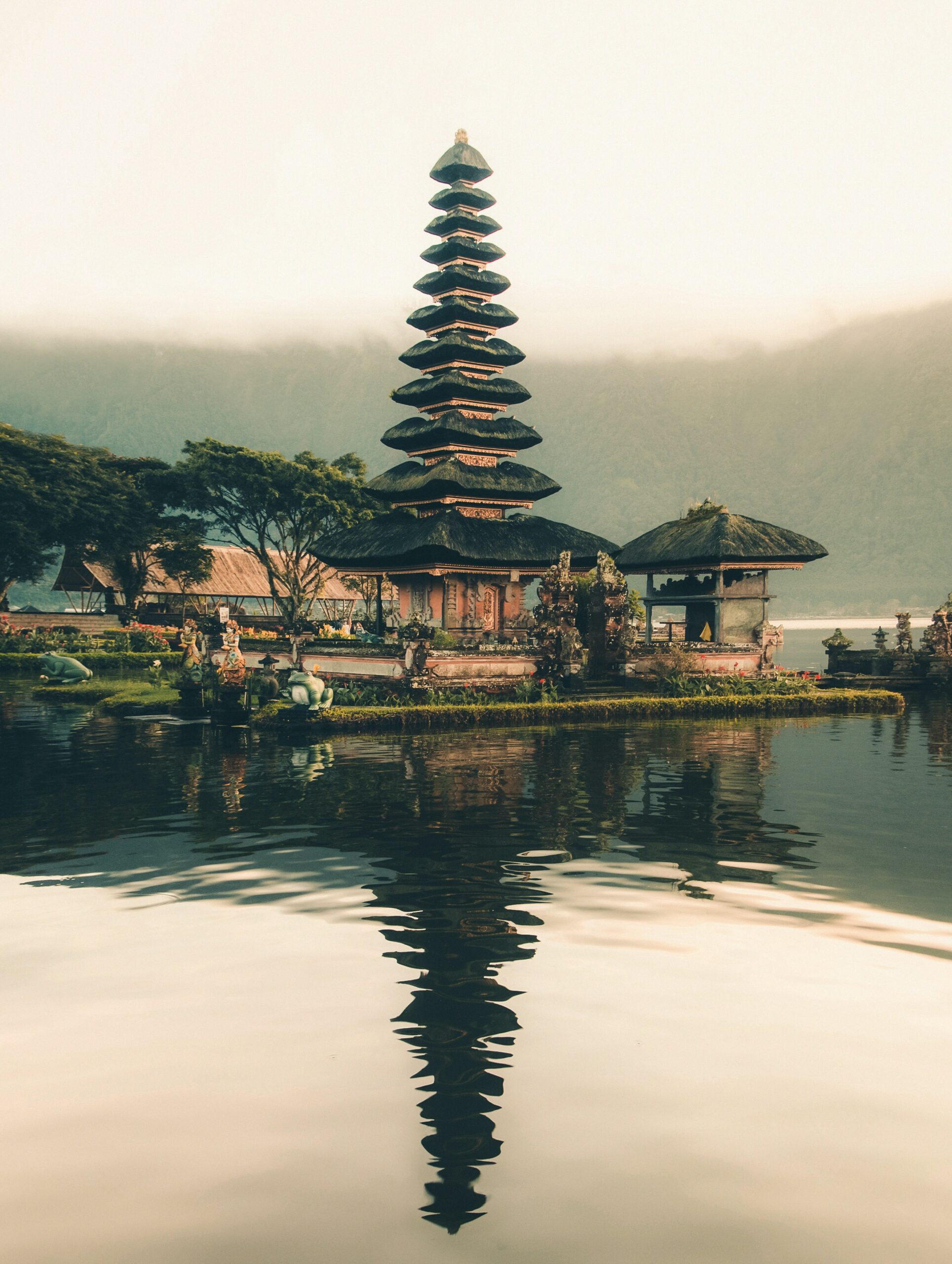
The Supply Chain: A Collaborative Effort
A tourism supply chain is like an intricate puzzle where each piece plays a vital role in making your vacation possible. It involves both producers, who create the foundational elements of your trip, and intermediaries, who connect these elements to you as the traveler.
Key players in the tourism supply chain include:
Producers:
- Suppliers: These are the businesses providing essential materials and goods, such as fresh seafood for your beachside dinner or the fluffy towels in your hotel room.
- Service Providers: These include the hotel staff ensuring your room is clean, the maintenance team keeping your air conditioning running smoothly, and the chefs preparing your meals.
Intermediaries:
- Travel Agents and Online Booking Platforms: These intermediaries help you book flights, accommodations, and tours by connecting you with producers.
- Tour Operators: They bundle services like transportation, guided tours, and cultural experiences into a cohesive package for your convenience.
Supporting Roles:
- Technology Providers: They ensure online booking systems are functional and secure, allowing you to make reservations effortlessly.
- Human Resources: They train professionals like your charismatic tour guide, whose knowledge and enthusiasm make your trip unforgettable.
Together, producers and intermediaries collaborate to create a seamless experience that transforms individual services into a memorable vacation.
Tourism supply chains are complex networks of interconnected producers (businesses and activities) that work together to deliver tourism products and experiences to consumers[1]. These supply chains encompass a wide range of sectors and services, from transportation and accommodation to attractions and local suppliers. They are often fragmented, involving numerous small and medium-sized enterprises, and are influenced by perishability, seasonality, and interdependence.
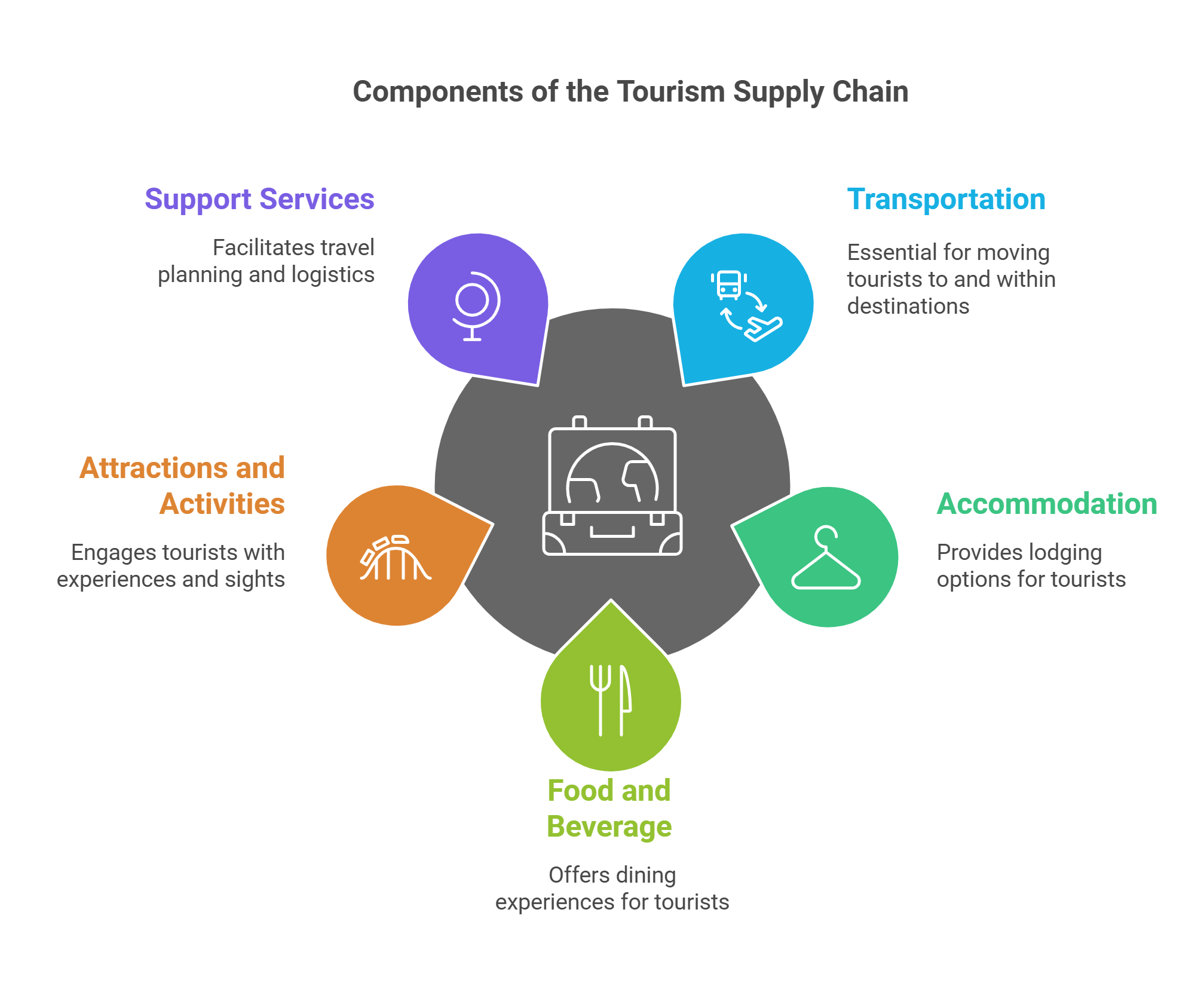
Tourism Product Producers
Unlike other sectors, tourism products are unique in that they represent the final outputs — experiences such as recreation, education, and relaxation — resulting from a complex production process.
This process involves three key components:
- Primary Inputs: Resources like land, labour, and capital.
- Intermediate Inputs: Facilities such as parks, resorts, and transportation.
- Intermediate Outputs: Services like guided tours and cultural performances.
Stephen Smith, in his 1994 paper The Tourism Product[2], referred to this process as the “tourism production function” (see Figure 3). It highlights how tourism products are created through the collaboration of multiple producers, supported by and connected through intermediaries (support services).
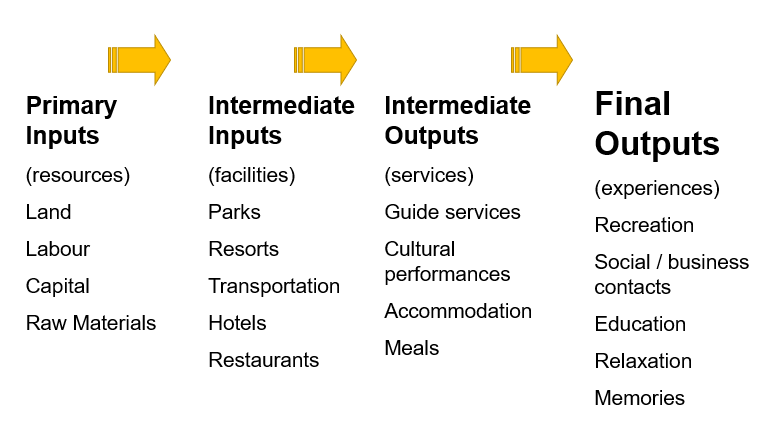
Examples
Tourism Product Producers
Accommodation Providers:
- Hotels: Ranging from budget to luxury establishments, such as Marriott International, Hilton Hotels & Resorts, and boutique hotels.
- Resorts: All-inclusive resorts and destination resorts like Sandals or Club Med.
- Vacation Rentals: Property owners who list their homes on platforms like Airbnb or VRBO.
- Camping and Glamping Sites: Providers of outdoor accommodation experiences.
Transportation Services:
- Airlines: Both major carriers (e.g., Air Canada and United Airlines) and budget airlines (e.g., WestJet and Ryanair).
- Cruise Lines: Companies like Royal Caribbean, Carnival Cruise Line, and Norwegian Cruise Line.
- Rail Services: Providers of scenic or long-distance train journeys, such as Rocky Mountaineer or Amtrak.
- Car Rental Companies: Enterprise, Hertz, and local car rental services.
Food and Beverage Establishments:
- Restaurants: From fine dining establishments to casual eateries and fast-food chains.
- Bars and Nightclubs: Venues offering drinks and entertainment.
- Wineries and Breweries: Producers of alcoholic beverages that often offer tours and tastings.
- Food Trucks and Street Food Vendors: Mobile food service providers.
Attractions and Activities:
- Attractions and Entertainment:
-
- Theme Parks: Disney Parks, Universal Studios, and regional amusement parks.
- Museums and Art Galleries: Both public institutions and private collections open to visitors.
- Natural Attractions: National and provincial parks, such as Banff National Park or Niagara Falls.
- Cultural and Historical Sites: Heritage buildings, monuments, and archaeological sites.
- Tour Operators and Activity Providers:
-
- Adventure Tour Companies: Providers of activities like white-water rafting, zip-lining, or skiing.
- Guided Tour Operators: Companies offering city tours, food tours, or specialized excursions.
- Ecotourism Providers: Organizations focusing on sustainable and nature-based experiences.
- Cultural Experience Facilitators: Companies offering immersive local experiences or workshops.
- Event and Conference Organizers:
-
- Convention Centres: Facilities designed to host large-scale events and conferences.
- Wedding and Event Planners: Professionals who create and manage special occasions.
- Festival Organizers: Producers of music festivals, cultural celebrations, and other large events.
Together, tourism product producers form the foundation of the tourism product, creating the experiences and services that attract and serve travelers. They often work in conjunction with intermediaries and other stakeholders to deliver comprehensive tourism products to consumers.
Tourism Intermediaries (Support Services)
Distribution channels in the tourism, hospitality, and services sectors involve several key intermediaries that play crucial roles in connecting service providers with end consumers.
These intermediaries perform specific functions such as:
- Providing information about destinations, accommodations, and activities
- Bundling different travel components into packages
- Handling bookings and reservations for various travel services
- Managing financial transactions between providers and travelers
- Offering customer support before, during, and after the travel experience
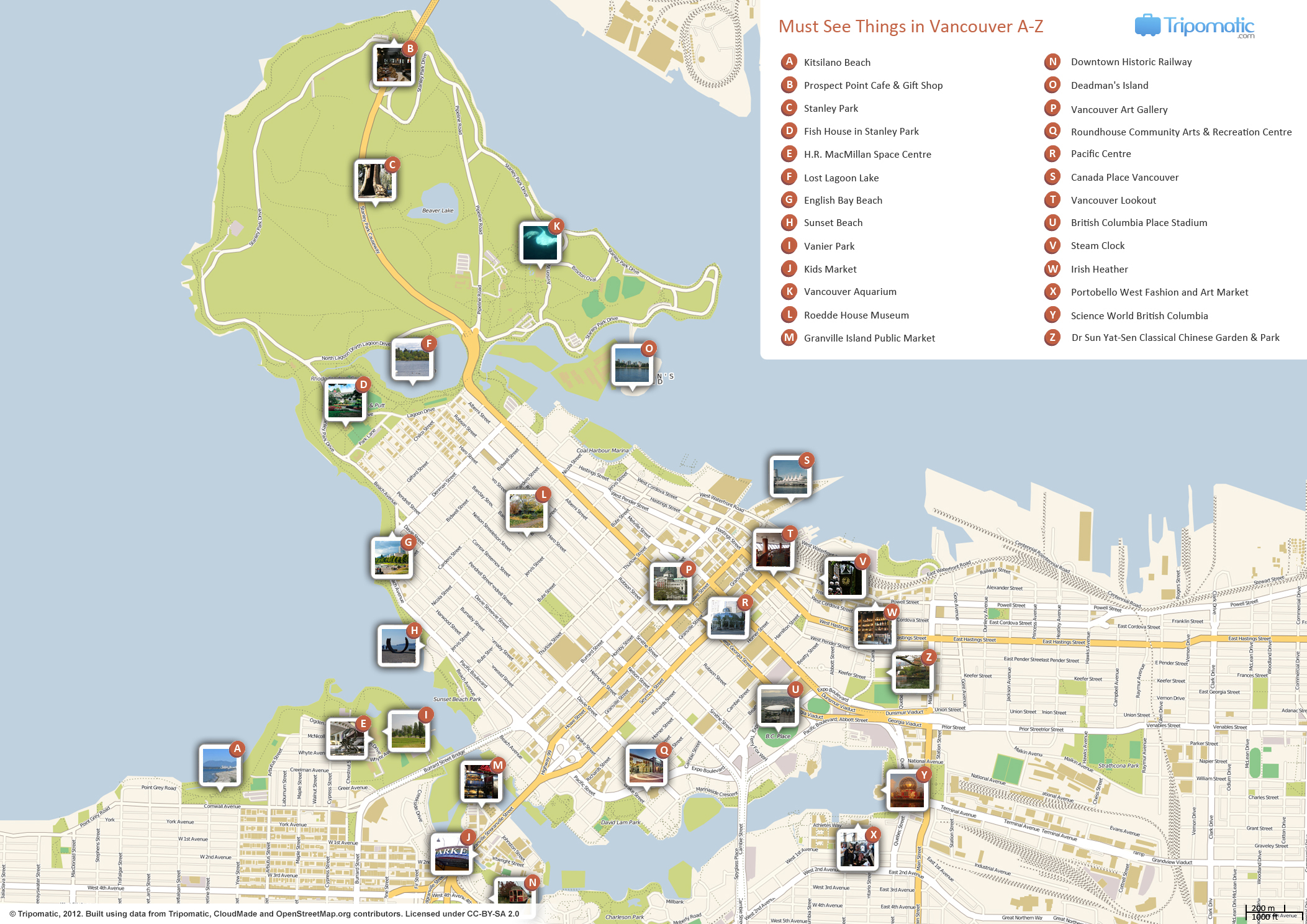
The main types of intermediaries are:
- Retailers
- Online platforms
- Wholesalers
- Agents/brokers
- Distributors
- Destination marketing/management organizations
Retailers
Retailers are businesses that sell products or services directly to end consumers.
Examples
Retailers
Local Tour Operators: Often act as retailers by selling excursions and activities directly to tourists.
Hotel Gift Shops: Sell souvenirs, local crafts, and travel essentials to guests.
Airport Duty-Free Stores: Offer luxury goods, alcohol, and cosmetics to travelers.
Online Platforms
E-commerce sites and online travel agencies (OTAs) have become increasingly important intermediaries.
Examples
Online Platforms
Online Platforms as a New Type of Intermediary
Online platforms often act as intermediaries that sell products or services directly to end consumers, which aligns with the traditional definition of a retailer. However, they also possess unique characteristics that set them apart from conventional brick-and-mortar retailers.
Online Platforms as Retailers:
- Direct Sales: Many online platforms, such as online travel agencies (OTAs) like Expedia and Booking.com, sell travel products and services directly to consumers.
- E-commerce Functionality: These platforms provide the infrastructure for transactions, including secure payment processing and booking confirmations, similar to traditional retailers.
- Customer Interface: They offer a user-friendly interface where consumers can browse, compare, and purchase products or services, much like a physical retail store.
Unique Characteristics:
- Aggregation: Unlike traditional retailers, online platforms often aggregate offerings from multiple suppliers, providing a wider range of choices to consumers.
- Dynamic Pricing: Many online platforms use sophisticated algorithms to adjust prices in real-time based on demand, competition, and other factors.
- User-Generated Content: These platforms frequently incorporate customer reviews and ratings, which influence purchasing decisions.
Examples in Tourism and Hospitality
Expedia, Booking.com, and Airbnb connect accommodation providers with travelers:
- Airbnb: Acts as a retailer by facilitating direct bookings between travelers and accommodation providers.
- TripAdvisor: While primarily known for reviews, it also functions as a retailer by allowing direct bookings for tours, activities, and restaurants.
- OpenTable: This platform retails restaurant reservations directly to diners.
While online platforms share many characteristics with traditional retailers, they also introduce new dynamics to the retail landscape. Their ability to connect multiple suppliers with consumers, provide extensive information, and offer convenient booking processes has significantly impacted the distribution channels in the tourism and hospitality industries.
Wholesalers
Wholesalers purchase products or services in bulk from producers and sell them to retailers.
Examples
Wholesalers
Tour Wholesalers: Buy large blocks of hotel rooms, airline seats, or cruise cabins at discounted rates.
Food Service Distributors: Purchase bulk quantities of ingredients and supplies to sell to restaurants and hotels.
Beverage Wholesalers: Supply alcoholic and non-alcoholic drinks to bars, restaurants, and hotels.
Agents/Brokers
Agents and brokers facilitate sales between producers and consumers without taking ownership of the products.
Examples
Agents/Brokers
Travel Agents: Are the most prominent example in the tourism sector as they book travel arrangements for clients.
Corporate Travel Management Companies: Act as specialized agents for business travelers.
Restaurant Brokers: Facilitate the sale and purchase of food service establishments.
Hotel Brokers: Assist in the buying and selling of hotel properties.
Distributors
Distributors in tourism and hospitality sectors act as intermediaries, connecting producers with consumers by aggregating, promoting, and delivering products and services while ensuring accessibility, convenience, and market reach.
Examples
Distributors
Global Distribution Systems (GDS): Platforms like Amadeus or Sabre act as intermediaries that connect service providers (e.g., hotels, airlines, and car rental companies) with travel agencies and online travel agencies (OTAs).
Example: A travel agent booking a flight and hotel package for a customer uses a GDS to access real-time availability and pricing across multiple providers.
Food and Beverage Distributors: These distributors supply essential products to restaurants, hotels, and catering companies.
Example: Food distributor might deliver fresh produce, beverages, or specialty ingredients to a resort’s kitchen to ensure it can meet guest dining needs.
Linen and Uniform Services: Companies specializing in linen and uniform distribution provide hotels and restaurants with clean textiles such as bed sheets, towels, tablecloths, and staff uniforms.
Example: A hotel might partner with a linen service to ensure a consistent supply of fresh linens for guest rooms while outsourcing the cleaning and maintenance of these items.
Destination Marketing/Management Organizations
A destination marketing/management organization (DMO) is a facilitating intermediary in the tourism industry. Unlike traditional intermediaries that directly sell products or services (e.g., travel agents or OTAs), DMOs focus on promoting and coordinating a destination’s offerings. They act as non-transactional intermediaries, connecting service providers (e.g., hotels, attractions, tour operators) with potential travelers and distribution channels through marketing, branding, and stakeholder collaboration. Their primary role is to enhance the visibility and appeal of a destination rather than directly handling bookings or sales[3].
Destination marketing/management organizations (DMOs) differ from other types of intermediaries in several key ways:
Non-Transactional Role: Unlike travel agents, online travel agencies (OTAs), or tour operators, DMOs do not directly sell tourism products or handle bookings. Instead, they focus on promoting the destination and connecting service providers with distribution channels and travelers.
Destination-Centric Focus: DMOs represent and market entire destinations rather than individual tourism products or services. Their goal is to enhance the overall appeal of a location by showcasing its attractions, accommodations, events, and cultural experiences.
Stakeholder Coordination: DMOs act as a central hub, bringing together various stakeholders such as local governments, tourism businesses, community organizations, and residents to align efforts in promoting and managing the destination.
Market Development and Branding: While other intermediaries focus on selling specific services or packages, DMOs are responsible for creating and maintaining the destination’s brand image through advertising campaigns, public relations efforts, and participation in trade shows.
Data Collection and Insights: DMOs gather market intelligence on traveler preferences, trends, and competitor destinations to guide local businesses in improving their offerings. Other intermediaries typically focus on transactional data related to bookings or sales.
Long-Term Destination Management: Unlike other intermediaries that prioritize short-term sales, DMOs are involved in sustainable destination development by advocating for infrastructure improvements, environmental conservation, and community engagement.
By focusing on promotion, coordination, and long-term planning rather than direct sales or transactions, DMOs play a unique role as facilitators within the tourism supply chain.
Examples
Canadian DMOs
Destination Canada: A national-level DMO that promotes Canada as a premier international tourism destination. It works with industry stakeholders to market Canadian experiences across diverse regions and seasons.
Destination BC: British Columbia’s provincial DMO, which operates the HelloBC platform to promote the province’s attractions, accommodations, and events. It also supports six regional destination marketing organizations (RDMOs) in BC.
Regional DMOs in BC:
- Tourism Vancouver Island (4VI): Promotes tourism on Vancouver Island with a focus on sustainability.
- Thompson Okanagan Tourism Association (TOTA): Markets the Thompson Okanagan region, known for its wineries and outdoor activities.
- Kootenay Rockies Tourism: Highlights the region’s mountain landscapes and adventure opportunities.
Local DMOs:
- Destination Vancouver: Focuses on marketing Vancouver as a top urban destination for leisure, business, and events.
- Tourism Whistler: Promotes Whistler as a year-round destination for skiing, biking, and cultural events.
- Tourism Kamloops: Showcases Kamloops as an outdoor adventure hub and cultural destination.
Challenges in Tourism Supply Chain Management
Tourism supply chain management faces several challenges[4] due to its unique characteristics, such as fragmentation, seasonality, and perishability. Below are some key challenges and examples[5].
Examples
Challenges in Tourism Supply Chain Management
Coordination: Aligning the interests and operations of diverse stakeholders — such as hotels, airlines, tour operators, and local suppliers — is complex due to conflicting objectives and interdependencies.
Example: Hotels may prioritize maximizing revenue through direct bookings, while tour operators focus on securing lower rates for group packages.
Quality Control: Ensuring consistent quality across all touchpoints of the tourist experience is difficult when multiple providers are involved.
Example: A luxury tour operator must rely on third-party transportation services and accommodations to meet high customer expectations, which can vary in quality.
Risk Management: External factors such as natural disasters, political instability, or pandemics can disrupt the entire supply chain.
Example: During the COVID-19 pandemic, many tourism businesses faced disruptions in supply chains due to lockdowns and reduced international travel.
Sustainability: Balancing economic growth with environmental and social responsibility is an ongoing challenge.
Example: Integrating sustainable practices into supply chains — such as sourcing locally or reducing carbon footprints — requires collaboration among stakeholders and often increases costs.
Distribution Channels in Tourism
Distribution channels in tourism are the pathways that connect travelers with their desired travel experiences. These channels serve as the interface between service providers and consumers, facilitating the purchase of tourism products and services.
Examples
Types of Distribution Channels in Tourism
Direct Channels: Direct channels involve a direct transaction between the service provider and the consumer, with no intermediaries involved.
Example: Booking a room directly through a hotel’s website or calling a family-run bed and breakfast to make a reservation.
Indirect Channels: Indirect channels involve one or more intermediaries between the service provider and the consumer. These can be categorized based on the number of intermediaries involved:
- One-Level: Involves a single intermediary, such as a local travel agency.
- Two-Level: Includes two intermediaries, such as a travel agency booking through a wholesaler with special hotel deals.
- Three-Level: Adds another layer, like a specialized adventure tour operator working with wholesalers and travel agencies.
Example: Using online travel agencies (OTAs) like Expedia or Booking.com to reserve accommodations.
Hybrid Channels: Hybrid channels combine elements of both direct and indirect distribution, allowing service providers to diversify their reach.
Example: A hotel that accepts direct bookings through its website while also listing rooms on various online platforms.
Significance of Distribution Channels
The choice of distribution channels can significantly impact a tourism business’s visibility, reach, and profitability. Each channel type offers distinct advantages:
- Direct channels often provide higher profit margins and greater control over the customer experience.
- Indirect channels can offer broader market reach and specialized expertise.
- Hybrid approaches allow businesses to balance the benefits of both direct and indirect channels.
Example
Distribution Channels for a Boutique Hotel
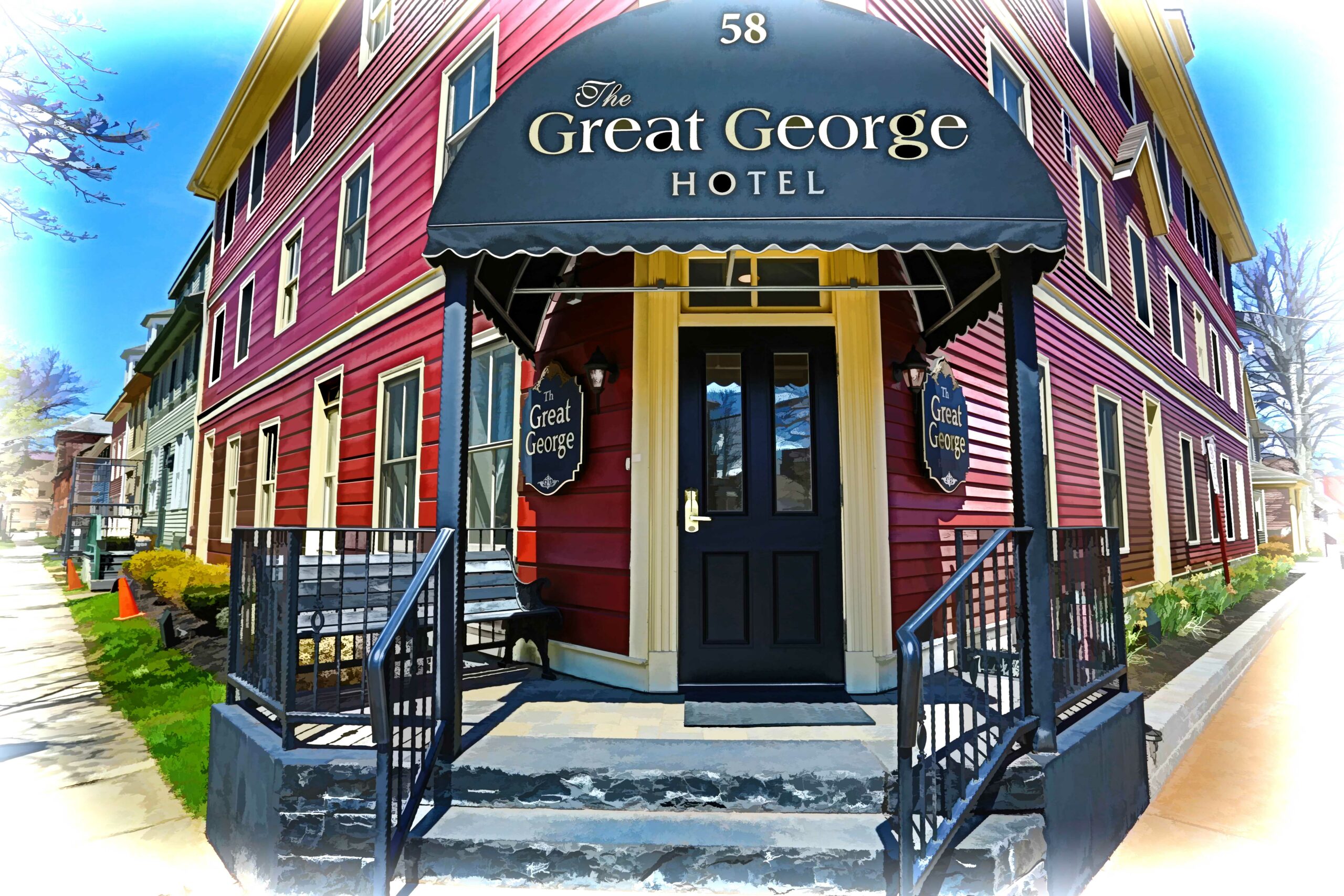
A distribution strategy for a boutique hotel like The Great George Hotel in Charlottetown, PEI, would focus on leveraging various distribution channels to effectively connect with its target market while maintaining operational control and profitability. Here is an example of a tailored distribution chain strategy:
Direct Distribution Channels:
- Hotel Website with Booking Engine: The Great George Hotel can prioritize direct bookings through its own website, offering an intuitive and secure booking system. This ensures full control over customer interactions and eliminates third-party commission fees. Exclusive offers, such as discounted rates for direct bookings or personalized packages, can further incentivize this channel.
- On-Site Reservations: The hotel can encourage walk-in bookings by maintaining a well-staffed front desk and offering flexible check-in options for last-minute travelers.
- Partnerships with Local Businesses: Collaborating with nearby attractions, restaurants, and event venues to create bundled packages (e.g., a “Stay and Dine” package) allows the hotel to directly reach customers through these partners.
Indirect Distribution Channels:
- Online Travel Agencies (OTAs): Listing rooms on platforms like Booking.com, Expedia, and Agoda increases visibility among international and domestic travelers who use these platforms for convenience and price comparison. This channel is particularly useful for reaching guests unfamiliar with the region.
- Global Distribution Systems (GDS): Partnering with GDS platforms like Amadeus or Sabre enables travel agents to book rooms for their clients, particularly corporate or group travelers. This expands the hotel’s reach into business travel markets.
- Destination Marketing Organizations (DMOs): Collaborating with organizations like Discover Charlottetown or Tourism PEI ensures inclusion in destination-wide marketing campaigns and travel itineraries. These DMOs often feature partner hotels on their websites and promotional materials, helping attract visitors planning trips to PEI.
- Travel Agents: Partnering with niche travel agencies that specialize in luxury or boutique accommodations allows the hotel to tap into specific customer segments, such as honeymooners or cultural tourists.
Hybrid Channels:
- Channel Managers: Utilizing a channel management system ensures seamless integration across all booking platforms (direct website, OTAs, and GDS), synchronizing room availability and pricing to avoid overbookings or inconsistencies.
Distribution Strategy Considerations:
- Selective Distribution: Focus on selective channels that align with the hotel’s luxury boutique positioning, avoiding mass-market platforms that may dilute the brand image.
- Performance Monitoring: Regularly evaluate the performance of each channel based on booking volume, revenue generation, and cost-effectiveness to optimize the distribution mix.
- Adapting to Trends: Stay competitive by incorporating emerging distribution technologies such as mobile booking apps or AI-driven personalization tools.
By combining direct channels for profitability and control with indirect channels for broader market reach, The Great George Hotel can effectively manage its distribution strategy while maintaining its reputation as a premier boutique property in Charlottetown.
Examples
Distribution Channels for an Adventure Tour Operator

A distribution strategy for an adventure tour operator offering bungee jumping experiences in Whistler, BC, could include the following channels:
Direct Distribution Channels:
- Company Website: The operator can use its website as the primary booking platform, providing detailed information about the bungee jumping experience, safety measures, pricing, and availability. This ensures full control over customer interactions and avoids third-party commissions.
- On-Site Sales: Offering direct bookings at the bungee jumping location allows walk-in customers or those already in Whistler to book their experience on the spot.
- Local Partnerships: Collaborating with nearby accommodations (e.g., hotels, hostels, or resorts) and restaurants to promote and sell tickets directly to their guests.
Indirect Distribution Channels:
- Online Travel Agencies (OTAs): Listing the experience on platforms like Viator, GetYourGuide, or Adrenaline allows the operator to reach a global audience of travelers searching for adventure activities in Whistler.
- Destination Marketing Organizations (DMOs): Partnering with organizations like Tourism Whistler or Destination BC ensures inclusion in destination-wide marketing campaigns and itineraries. These DMOs often feature local adventure activities on their websites and promotional materials.
- Travel Agents and Tour Operators: Collaborating with travel agencies or larger tour operators that offer adventure packages in Whistler can help attract group bookings or international visitors.
- Visitor Centers: Working with local visitor centers in Whistler to sell tickets or promote the experience to tourists seeking adventure activities during their stay.
Hybrid Channels:
- Channel Management Software: Using tools like TrekkSoft or Zaui to synchronize availability across all channels (website, OTAs, and visitor centres) ensures seamless inventory management and avoids overbookings.
By combining direct channels for control and profitability with indirect channels for broader market reach, this strategy ensures that the bungee jumping operator can effectively attract both local thrill-seekers and international adventure travelers.
Distribution Mix Decisions
When deciding on a distribution mix in tourism, hospitality and leisure sectors, there are several key objectives to consider.
Examples
Distribution Mix Objectives
Satisfying Customer Needs: The distribution mix should provide convenient access and booking options that align with target customer preferences and behaviours.
Example: A boutique hotel targets millennial travelers who prefer mobile-friendly booking platforms. To meet their needs, the hotel integrates its booking system with apps like Airbnb and offers instant booking on its website.
Maximizing Profits: The mix should balance reach and sales volume with profitability, considering costs like commissions for each channel.
Example: A luxury resort uses its direct website for bookings to avoid high commission fees charged by OTAs while still listing on OTAs like Booking.com to maintain visibility and capture additional sales.
Achieving Desired Market Coverage: The channels selected should provide adequate coverage of target market segments and geographic regions.
Example: A tour operator offering cultural experiences in Europe partners with local travel agencies in North America and Asia to reach international travelers while also using its website for direct bookings.
Balancing Direct and Indirect Channels: Finding the right mix of direct (e.g. own website) and indirect (e.g. OTAs) channels to optimize control and reach.
Example: An airline sells tickets directly through its website and app but also partners with OTAs like Expedia to reach budget-conscious travelers who compare prices across platforms.
Managing Channel Conflicts: Designing a mix that minimizes conflicts between different distribution partners.
Example: A hotel chain ensures price parity across all channels (direct website, OTAs, and travel agents) to avoid conflicts where one channel undercuts another, creating dissatisfaction among partners.
Optimizing Channel Performance: Selecting channels that perform well in terms of booking volume, revenue generation, and cost-effectiveness.
Example: A ski resort evaluates its distribution channels annually and finds that its partnership with a regional DMO generates the highest volume of bookings during peak season, so it increases investment in that channel.
Aligning With Overall Marketing Strategy: The distribution mix should support broader marketing and branding objectives.
Example: An eco-lodge aligns its distribution mix with its eco-friendly branding by partnering with niche travel platforms that focus on green tourism rather than mass-market OTAs.
Adapting to Market Trends: Incorporating emerging channels and technologies to stay competitive.
Example: A family-owned bed-and-breakfast (B&B) adapts to market trends by integrating with emerging platforms like Google Hotel Ads, which allows potential guests to see real-time availability and prices directly in search results. Additionally, the B&B adopts a chatbot on its website to provide instant responses to inquiries, catering to the growing demand for quick and convenient customer service. These changes help the business remain competitive against larger hotel chains and appeal to tech-savvy travelers[6].
Managing Inventory Effectively: Ensuring proper allocation and availability across channels to maximize occupancy.
Example: A chain of vacation rentals uses a channel manager system to synchronize availability across multiple platforms — like Airbnb, Vrbo, and its own website — to avoid double bookings.
Gathering Market Intelligence: Using channels that provide valuable data on customer behaviour and market trends.
Example: An adventure tour company uses data from Google Analytics on its website and insights from OTA dashboards to track customer preferences, such as popular travel dates and preferred tour packages.
Enhancing Brand Visibility: Selecting channels that increase brand exposure to target audiences.
Example: A luxury hotel partners with high-profile OTAs like Expedia and niche platforms such as Mr & Mrs Smith[7] to increase its exposure to both mass-market and upscale travelers. Additionally, it collaborates with influencers on Instagram to showcase its unique amenities, further enhancing brand recognition among its target audience.
Supporting Different Customer Segments: Using a mix of channels to cater to various customer types (e.g. leisure, business, groups).
Example: A resort uses multiple channels to cater to diverse customer types: it offers corporate packages through direct sales to businesses for conferences, lists leisure packages on OTAs like Booking.com for individual travelers, and works with group travel agencies to attract family reunions and large tour groups.
The goal is to create a balanced distribution mix that effectively reaches target customers, maximizes revenue and profitability, aligns with overall business strategy, and provides flexibility to adapt to market changes.
Media Attributions
- Figure 1: “Temple beside body of water and trees” by Aron Visuals (2018), via Unsplash, is used under the Unsplash license.
- Figure 2: “Components of the tourism supply chain” [created using Napkin.ai] by the author is under a CC BY-NC-SA 4.0 license.
- Figure 3: “The tourism production function” by the author is adapted from Table 1 in “The Tourism Product” (Smith, 1994) under Fair Dealing guidelines.
- Figure 4: “Vancouver printable tourist attractions map” by Tripomatic.com (2012), via Wikimedia Commons, is used under a CC BY-SA 3.0 license.
- Figure 5: “The Great George Hotel” by Steve Sutherland (2014), via Flickr, is used under a CC BY 2.0 license.
- Figure 6: “Photo of Man Jumping” by Arun Mathew (2018), via Pexels, is used under the Pexels license.
- Zhang, X., Song, H., & Huang, G. Q. (2009). Tourism supply chain management: A new research agenda. Tourism Management, 30(3), 345–358. https://doi.org/10.1016/j.tourman.2008.12.010 ↵
- Smith, S. L. J. (1994). The tourism product. Annals of Tourism Research, 21(3), 582–595. https://doi.org/10.1016/0160-7383(94)90121-X ↵
- Morrison, A. M. (2023). Marketing and managing tourism destinations. Routledge. ↵
- Zhang, X., Song, H., & Huang, G. Q. (2009). Tourism supply chain management: A new research agenda. Tourism Management, 30(3), 345–358. https://doi.org/10.1016/j.tourman.2008.12.010 ↵
- Umar, M., Ahmad, R., & Radics, R. (2022). Tourism supply chains: Issues and resilience strategies during the global pandemic. Australasian Journal of Disaster and Trauma Studies, 26(Special Issue on Information Systems), 167–171. https://trauma.massey.ac.nz/issues/2022-IS/AJDTS_26_IS_Umar2.pdf ↵
- O’Connor, P. (2024). The democratization of tourism distribution: a Horizon 2050 paper. Tourism Review. https://doi.org/10.1108/TR-12-2023-0852 ↵
- Qubein, R. (2024, June 18). World of Hyatt adds 700 Mr & Mrs Smith boutique properties. Forbes. Retrieved from https://www.forbes.com/sites/ramseyqubein/2024/06/16/world-of-hyatt-adds-700-mr--mrs-smith-boutique-properties/ ↵
The network of tourism organizations engaged in different activities ranging from the supply of tourism components to the delivery of tourism products and services in a tourism destination.
A digital platform that allows consumers to book travel services such as accommodations, flights, and activities.

